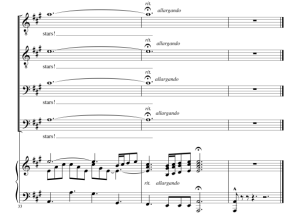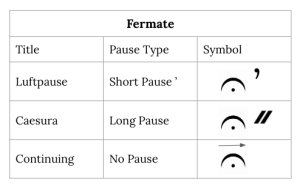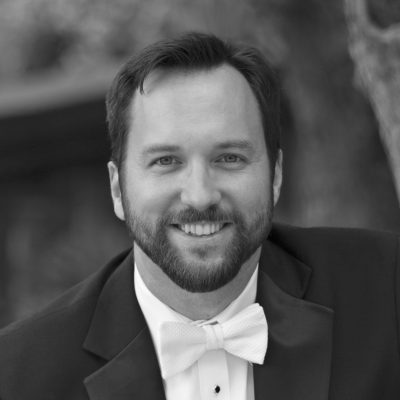5 Fermate
Troy Robertson
Learning Objectives
In this chapter, students will:
- Identify three types of fermata: short pause, long pause, and no pause.
- Apply the fermata to musical excerpts and explain their interpretation with musical language.
The fermata, often called a “hold” or “pause,” is a musical notation symbol indicating that the note or rest over which it is placed should be sustained longer than its usual duration. The word’s literal meaning is “stop” in Italian. Fermata can also be used over bar lines to indicate the end of a major section of music. Interpretation of fermata, including how long they should be held and whether or how long to pause afterward, is up to the conductor and should be informed by experience, study, and musical intuition.
One of the most famous examples of fermata (and its impact on musical effect) is the opening of Ludwig van Beethoven’s Symphony No. 5 in C Minor. Listen to the differences between the three performances linked below.
- What similarities and differences can you hear between these three performances?
- How do the subtle differences in each performance affect your perception of the piece?
- What factors do you think informed the decisions of each conductor?
1. Leonard Bernstein
2. Daniel Barenboim
3. Herbert von Karajan
Fermate Decision Making
As you can hear in each of the examples above, the conductor’s interpretation of fermata can have a dramatic effect on the performers and listeners. Before making decisions regarding the interpretation of a fermata, it is helpful to consider the historical background of the piece as well as the more general background of the fermata in music.
The practice of sustaining notes beyond their usual value predates the fermata symbol. In the late medieval and Renaissance eras, performers relied on experience, education, and local tradition to sustain at key moments, such as cadences. The fermata as notation began to appear in musical works in the 15th century and usually indicated that a note should be sustained longer than normal. Initially, composers used other symbols for this purpose as well, but by the Baroque period the familiar “bird’s eye” had become the standard. Even then, however, composers used this symbol to mean things other than “sustain” or “stop.” In Bach’s chorales, for example, the fermata means that the phrase is over and space should be left for a breath, with little or no additional time added to the final note. Mozart used fermatas to indicate space for a cadenza or, in the final double bar line of a piece, to communicate that the piece was truly over.
When faced with a fermata in a score, one must make several decisions.
When should the conducting pattern stop?
The conducting pattern should stop only after all the rhythmic activity in the score stops.
For example, in the musical excerpt below, the vocal lines sustain the fermata on beat one, but the piano accompaniment continues for two more beats before its fermata. The left hand may be employed to show the beginning of sustain for the voices while the right hand continues to show the conducting pattern until the fermata for the piano.

The hand or baton should continue to move smoothly during the sustain, but should not beat time. The direction of this movement should anticipate the needed movement of the subsequent cutoff or prep.
How long should the sustain last?
Several factors may contribute to this decision, and there is no single rule to guide the conductor in all situations.
The sustain may be measured (twice as long as the note indicated, for example) or unmeasured. Again, in either case the conductor should not continue to beat time, and instead pause the conducting pattern while very slowly moving the hand or baton in a gesture of sustain.
Factors one might consider when deciding how long to sustain should include the following:
- Performance practice and historical context (as in the chorales of Bach mentioned above)
- Performance elements of the piece (such as tempo, dynamic, or text)
- Extra-musical performance elements (such as the performance venue, ensemble size and experience, or intended audience)
How long should the pause last?
With regard to the pause, there are three options open to the conductor:
- Short pause – The note should be sustained then followed by a short pause consisting of nothing more than the time needed for the prep.
- Long pause – The note should be sustained, followed by a long pause in which the conductor does not conduct time, and then followed by the prep.
- No pause – The note should be sustained and the conductor should indicate the continuation of sound, followed by the prep.
The short pause is sometimes known as a “lift,” Luftpause, or breath lift. The long pause is sometimes known as a grand pause, Generalpause, or caesura. If no pause is needed, this is sometimes called a “continuing” fermata.

The cutoff after the fermata (if needed)
If a cutoff after the sustain is required, the conductor should cut off the ensemble using either the same beat as the initial sustain (if musical action resumes on the next beat) or the beat prior to the next musical action.
The preparatory gesture after the fermata
The preparatory gesture after a fermata is somewhat different from an initial prep.
- If the next note after the fermata falls on a strong beat, one beat of preparatory gesture will suffice
- If the next note after the fermata falls on a partial beat, a gesture of syncopation will suffice
- …unless there is a change in tempo after the fermata. In that case, an additional beat to establish the new tempo is advisable
Gesture for a fermata with no pause
In the case of a fermata with no musical pause, the conductor should sustain as normal, then speed up this gesture to show the prep. As is the case with an initial preparatory gesture, there are two main scenarios to anticipate:
- Preparatory gesture for a strong beat
- Preparatory gesture for a partial beat
EVALUATE
Fermate Competency Check
Demonstrate efficacy in the three types of fermate, including appropriate prep, cutoff, and re-entry:
1. Continuing
2. Luftpause
3. Caesura
Fermate Final Reflection
Find an example of the fermata in a piece of music you are rehearsing in an ensemble or studying in another class such as music theory or music history. Using YouTube or a music streaming service, find three interpretations of the fermata and compare and contrast them.
- Include links to the two videos you selected.
- Compare/Contrast their use of Fermate.
- What style was used? What markings in the score support that type of fermata?
- Which conductor/fermata choice seems to embody the music more? Why?

